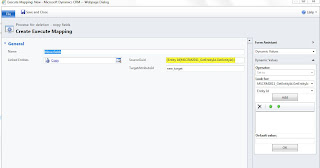Based on htmlbox - dynamics crm 2011 integretion described in here:
https://community.dynamics.com/product/crm/crmnontechnical/b/crmsoftwareblog/archive/2011/06/27/adding-wysiwyg-editor-to-textarea-in-microsoft-dynamics-crm-part-2-crm-2011.aspx
There are other tinyMCE - Dynamics crm 2011 integrations on the web for exmaple:
http://procentrix.com/Community/BrendenS/post.aspx?ID=13
IMPORTANT: This solution is unsupported.
Dynamics crm TinyMCE
Walkthrough:
- Get the minified Jquery from
http://jquery.com/ - Get the tinyMCE
http://www.tinymce.com/download/download.php - Use the web resource util as described here
http://blog.customereffective.com/blog/2011/06/using-crm-2011-web-resource-utility.html - Add the jquery and tinymce to the entity form
- Create new web resource with the following code and add it to the form
var textAreaName = "new_description"; function onLoad(textarea) { textAreaName = textarea; Xrm.Page.getAttribute(textAreaName).setSubmitMode("always"); //Xrm.Page.getControl("new_description").setVisible(false); //$('#new_description').css("width", "90%").css("height", "10%"); $('#' + textAreaName + '_d').append('<textarea id="wysiwyg" name="wysiwyg" style="width:90%;height:90%;">' + $("#" + textAreaName).val() + '</textarea>'); $('#' + textAreaName).hide(); tinyMCE.init({ mode : "exact", elements : "wysiwyg", theme : "advanced", plugins : "autolink,lists,pagebreak,style,layer,table,save,advhr,advimage,advlink,emotions,iespell,insertdatetime,preview,media,searchreplace,print,contextmenu,paste,directionality,fullscreen,noneditable,visualchars,nonbreaking,xhtmlxtras,template,inlinepopups,autosave", theme_advanced_buttons1 : "newdocument,|,bold,italic,underline,|,justifyleft,justifycenter,justifyright,fontselect,fontsizeselect,formatselect", theme_advanced_buttons2 : "cut,copy,paste,|,bullist,numlist,|,outdent,indent,|,undo,redo,|,link,unlink,anchor,image,|,code,preview,|,forecolor,backcolor", theme_advanced_buttons3 : "insertdate,inserttime,|,spellchecker,advhr,,removeformat,|,sub,sup,|,charmap,emotions", theme_advanced_toolbar_location : "top", theme_advanced_toolbar_align : "left", theme_advanced_statusbar_location : "bottom", theme_advanced_resizing : true, onchange_callback : "myCustomOnChangeHandler" }); } function myCustomOnChangeHandler(inst) { if(inst.isDirty()) { inst.save(); } Xrm.Page.getAttribute(textAreaName).setValue($('#wysiwyg').val()); return true; } function onSave() { for (var i=0; i<tinymce.editors.length; i++) { tinyMCE.execCommand('mceRemoveControl',false, tinymce.editors[i].id); }; $('#wysiwyg').remove(); }
- Add new onload event: function name: onLoad Parameter: "the attribute schema name"
- Add new onsave event: function name: onSave
- Save and publish...
You can download an example here (Replaces the entity task!):
unmanaged solution:
managed solution:









